Dealing with a cat that keeps pooping on the carpet can be frustrating and overwhelming for any pet owner. It’s important to understand that this behavior is not uncommon and can be a result of various factors. In this article, I will explore the insightful perspectives behind why cats exhibit this behavior and provide valuable solutions to address the issue.
When a cat repeatedly poops on the carpet, it can be indicative of behavior, training, or health-related problems. Cats are known for their cleanliness, so when they choose to eliminate outside their litter box, it can be a sign that something is amiss. Understanding the reasons behind this behavior is crucial in finding a solution and restoring harmony in your home.
Some potential reasons for a cat pooping on the carpet include aversion to the litter box, medical issues, marking territory, stress, anxiety, or a lack of proper training. Cats may develop an aversion to their litter box due to factors such as the type of litter, placement of the box, or cleaning frequency. Medical issues, such as urinary tract infections or digestive problems, can also contribute to this behavior.
Addressing litter box problems requires a comprehensive approach that involves behavior modification techniques, environmental changes, and sometimes even consultation with a veterinarian. By implementing consistency, routine, and reinforcement, you can help your cat develop better litter box habits and prevent accidents on your carpet.
It’s also essential to understand the significance of communication and body language in cats. By observing their behavior and providing a safe and stress-free environment, you can alleviate any anxiety or stress that may contribute to litter box problems.
Throughout this article, I will delve deeper into the various factors that can lead to a cat pooping on the carpet. From understanding medical issues to implementing behavior modification techniques, I will provide you with valuable insights and effective solutions to tackle this problem head-on.
Key Takeaways:
- Understanding the underlying causes of a cat pooping on the carpet is crucial for finding a solution.
- Factors such as litter box aversion, medical issues, and stress can contribute to this behavior.
- Behavior modification techniques, environmental changes, and consultation with a veterinarian can help address the problem.
- Consistency, routine, and reinforcement are essential in promoting better litter box habits.
- Observing communication and body language can alleviate anxiety and stress in cats.
Medical Problems
When a cat keeps pooping on the carpet, it could be a result of various medical problems. These issues can affect a cat’s normal urination and defecation behavior, leading to litter box problems. Inflammation of the urinary tract, for example, can cause pain, increased frequency, and urgency in urination. Kidney disease, diabetes mellitus, and digestive tract problems can also impact a cat’s litter box usage due to increased drinking, urination, and difficulties in defecation. Age-related diseases can further affect a cat’s mobility and cognitive function, making it challenging for them to reach the litter box in time.
It’s important for cat owners to be aware of these potential medical problems as they can contribute to house soiling behaviors. Seeking veterinary care and proper diagnosis is crucial in addressing the underlying medical issues.
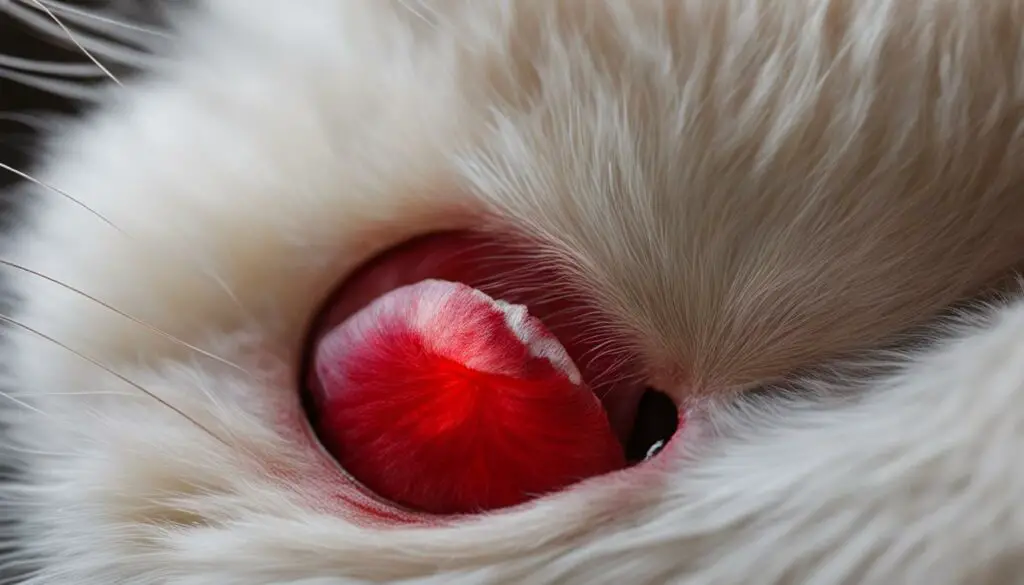
Litter Box Problems Table
| Medical Problems | Impact on Litter Box Usage |
|---|---|
| Inflammation of the urinary tract | Painful urination, increased frequency, and urgency |
| Kidney disease | Increased drinking and urination |
| Diabetes mellitus | Increased drinking and urination |
| Digestive tract problems | Painful defecation, difficulties in control over elimination |
| Age-related diseases | Difficulties in reaching the litter box in time |
Understanding and addressing these medical problems are essential steps in resolving litter box problems and promoting a healthier environment for both the cat and its owner.
Litter Box Aversions
Cats can develop aversions to their litter box, leading to house soiling. These aversions can be related to the litter box itself, the type of litter used, or the location of the box. Cats with litter box aversions may eliminate on unsavory surfaces such as carpets or hard surfaces like tile floors. They may also eliminate in bathtubs or other locations that are inconsistent with their litter box habits.
To address litter box aversions, it’s important to identify the underlying cause. Sometimes, a cat may have an aversion to the litter box due to the type of litter used. Cats have different preferences when it comes to litter texture and scent, so experimenting with different litter types may help. Additionally, the location of the litter box plays a crucial role. Some cats may prefer a more private and quiet location, while others prefer a more accessible and open area. Finding the right balance is essential.
“Cats with litter box aversions may eliminate on unsavory surfaces such as carpets or hard surfaces like tile floors.”
Cleaning the litter box regularly is also important to prevent aversions. Cats are clean animals and prefer a clean and odor-free litter box. If the box is not cleaned frequently enough, the cat may find it unpleasant and seek alternative elimination spots. Ensuring that the litter box is cleaned daily and maintaining good hygiene can help prevent aversions.
Lastly, creating a positive association with the litter box is crucial. Providing treats or praise when the cat uses the litter box correctly can reinforce the desired behavior. Conversely, punishment or negative reinforcement should be avoided, as it can create anxiety or fear around the litter box. Patience and understanding are key when addressing litter box aversions, as it may take time for the cat to adjust to any changes made.

Table: Comparing Litter Box Aversions
| Aspect | Symptoms | Possible Causes |
|---|---|---|
| Eliminating on unsavory surfaces | Eliminating on carpets, tile floors, or other surfaces | Aversion to litter box, preference for certain textures |
| Inconsistent litter box usage | Using the litter box inconsistently or sporadically | Aversion to litter box, discomfort, preference for alternative locations |
| Avoiding litter box | Refusing to use the litter box altogether | Aversion to litter box, trauma, past negative experiences |
Understanding and addressing litter box aversions can help resolve house soiling issues. By identifying the underlying causes, making necessary changes, and providing a positive and clean litter box environment, cat owners can encourage proper litter box usage and prevent aversions.
Inappropriate Site Preferences
Some cats may develop inappropriate site preferences when it comes to eliminating. They may have a specific type of surface or location that they prefer over the litter box. For example, cats may choose to eliminate on soft surfaces like clothing or carpets, or they may prefer hard surfaces like tile floors. These preferences can cause them to avoid the litter box altogether and choose a different spot in the house.
It’s important to understand that a cat’s preference for a new site may be a result of another house soiling issue, such as a medical problem that prevents them from reaching the litter box in time. Cats have their own unique preferences, and it’s essential to identify and address them in order to resolve the problem.
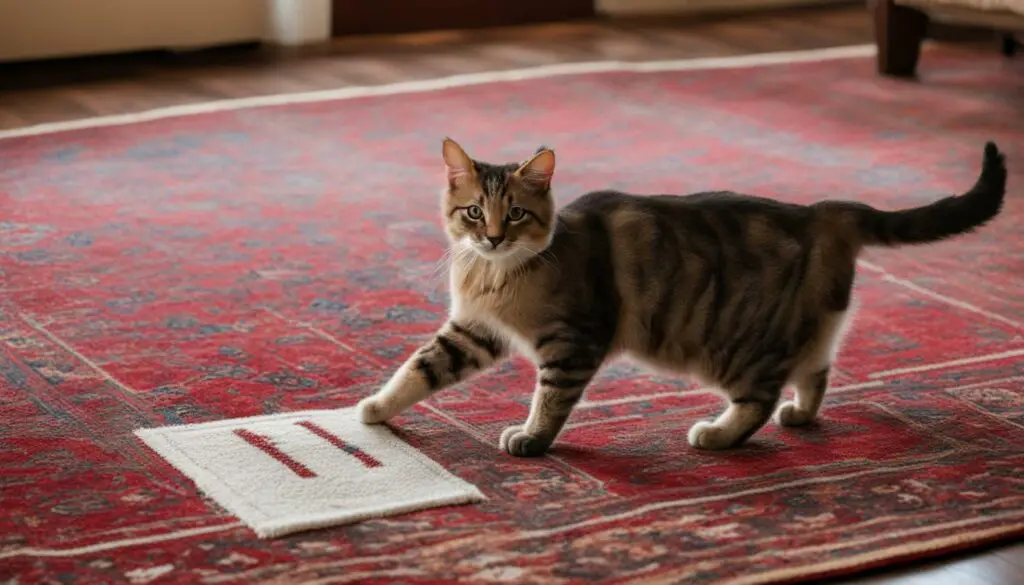
Factors Affecting Inappropriate Site Preferences
Several factors can influence a cat’s preference for certain surfaces or locations when eliminating. These include the current location of the litter box, the type of surface the cat prefers, and the presence of any new sites that attract the cat’s attention. By understanding these factors, we can gain insight into why a cat may be choosing to eliminate outside the litter box.
| Factors | Effects |
|---|---|
| Current Location of Litter Box | If the litter box is in a place that is difficult for the cat to access or is not easily visible, they may choose to eliminate elsewhere. |
| Type of Surface Preferred | Cats may have a preference for specific surfaces, such as soft or sandy textures, and may choose to eliminate on similar surfaces in the house. |
| Presence of New Sites | If there are new areas or objects in the house that attract the cat’s attention, they may choose to eliminate in those locations instead of the litter box. |
Understanding these factors can help cat owners make necessary adjustments to the litter box placement, provide alternative surfaces that mimic the cat’s preferences, or address any changes in the household environment that may be causing the cat to seek out new sites for elimination.
Section 5: Urine Spraying
Urine spraying is a common behavior exhibited by cats, especially in unneutered males and unspayed females. This marking behavior involves the cat releasing small amounts of urine onto vertical surfaces, such as walls or the backs of chairs, to communicate their presence and establish territory. While spraying is a natural behavior, it can become problematic when it occurs indoors, leading to frustration for cat owners and potential damage to furniture and carpets.
The scent of sprayed urine serves as a territorial mark, signaling the cat’s presence to other potential mates or perceived threats. Neutered males and spayed females may also engage in spraying behavior, although to a lesser extent. This can be influenced by factors such as territorial threats, changes in the environment, stress, frustration, or even dietary changes.
“Urine spraying is a natural behavior for cats, but it can be frustrating when it happens inside our homes.”
If you’re dealing with a cat that is spraying urine, it’s important to address the underlying causes and implement strategies to modify the behavior. Environmental changes, such as providing ample opportunities for vertical scratching, ensuring access to clean litter boxes, and reducing stressors in the cat’s environment, can help alleviate spraying behavior. Neutering or spaying your cat can also significantly reduce their inclination to spray.
| Factors Influencing Urine Spraying | Examples |
|---|---|
| Territorial threat | Introducing a new pet or rearranging furniture |
| Frustration | Changes in diet or the presence of new furniture |
| Stress | Environmental changes or lack of routine |
Preventing and Managing Urine Spraying
Preventing and managing urine spraying requires a multi-faceted approach. Providing a clean and appropriate litter box environment, ensuring social and environmental enrichment, and using pheromone sprays or diffusers can help deter spraying behavior. Additionally, consulting with a veterinarian or a veterinary behaviorist can provide further guidance and potential medication options to address underlying anxiety or stress-related issues.
- Ensure access to clean litter boxes
- Reduce stressors in the environment
- Use pheromone sprays or diffusers
- Consult with a veterinarian or veterinary behaviorist
What You Can Do to Stop Litter Box Problems
If you’re dealing with a cat that keeps pooping on the carpet, it’s important to address the problem as soon as possible. Here are some steps you can take to stop litter box problems and promote better litter box habits:
- Identify the responsible cat: If you have multiple cats in your household, it’s crucial to determine which one is causing the house soiling. You can separate the cats temporarily or use special stains or dyes to identify the cat responsible for urine puddles or feces.
- Distinguish between spraying and house soiling: It’s important to understand the difference between spraying and house soiling. Spraying is a behavior where cats mark their territory by urinating on vertical surfaces, while house soiling refers to eliminating outside the litter box. This distinction can help you identify the appropriate solutions for your cat’s behavior.
- Consult a veterinarian: Take your cat for a medical examination and diagnostic tests to rule out any underlying medical causes for the litter box problems. Medical issues such as urinary tract inflammation or digestive tract problems can contribute to house soiling behavior.
- Identify the cause: Once any medical issues have been ruled out, work on identifying the cause of the litter box problems. This may involve modifying the litter type, litter box placement, size, or cleaning frequency. Some cats may benefit from having multiple litter boxes available in different areas of the home.
Additionally, medication may be prescribed by a veterinarian to help address any underlying issues or behavior problems. It’s important to follow the recommended dosage and consult with your veterinarian about any potential side effects of the medication.
Lastly, make sure to clean any cat-soiled items promptly and thoroughly using products that neutralize odors. Avoid using cleaning products that contain ammonia or vinegar, as they can have smells similar to urine and may irritate the cat. Cleaning cat-soiled items properly can help break the cycle of elimination and discourage re-marking.
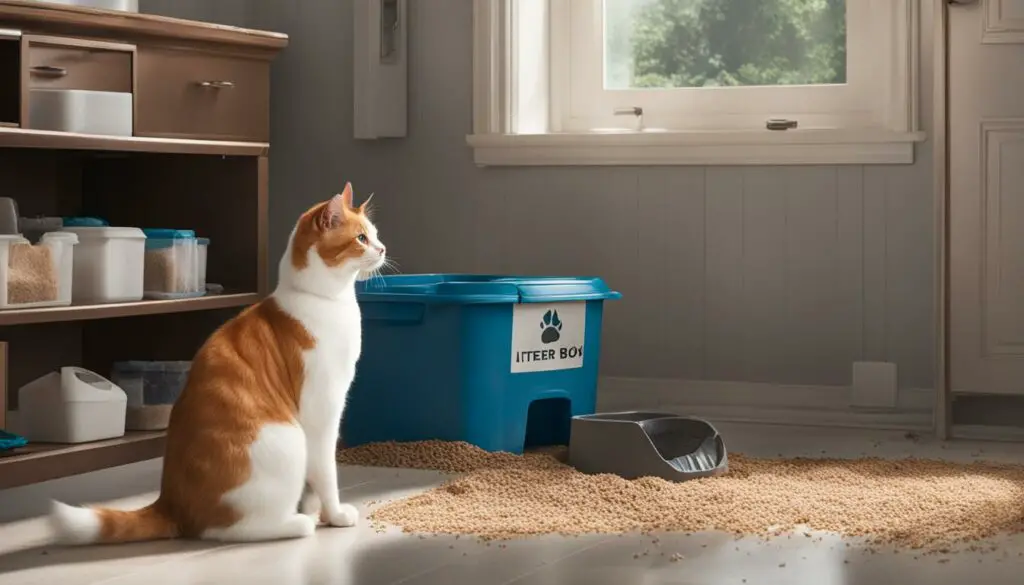
Table: Common Methods to Address Litter Box Problems
| Method | Description |
|---|---|
| Identify the responsible cat | Separate or use special stains/dyes for identification |
| Distinguish spraying vs. house soiling | Understand the difference between the behaviors |
| Consult a veterinarian | Rule out any underlying medical causes |
| Identify the cause | Modify litter, litter box placement, size, or cleaning frequency |
| Medication | Prescribed by a veterinarian, if necessary |
| Cleaning cat-soiled items | Thoroughly clean with odor-neutralizing products |
Will Medications Stop My Cat From House Soiling?
Cats that engage in house soiling behavior, such as urinating or defecating outside the litter box, can be frustrating for owners. While medications, particularly anti-anxiety drugs, may help prevent spraying behavior in cats, they are not a complete solution on their own. Medication should be used in conjunction with other strategies, such as environmental changes and behavioral modification techniques, to effectively address the issue.
When considering medications for house soiling, it is important to consult with a veterinarian. They can assess your cat’s specific situation and determine if medication is appropriate. Additionally, veterinary monitoring is crucial to ensure the medication’s effectiveness and to identify any potential side effects.
It’s worth noting that medication should not be the sole focus of addressing house soiling. Environmental changes, such as providing multiple litter boxes, maintaining cleanliness, and addressing any stressors in the cat’s environment, are essential components of a comprehensive approach. Working with a veterinarian or veterinary behaviorist can provide further guidance in implementing these strategies and finding the best solution for your cat’s specific needs.

Section 8: What Can I Use to Clean My Cat-Soiled Carpet and Household Items?
When it comes to cleaning cat-soiled items, it’s essential to use the right products and techniques to ensure effective odor neutralization and prevent re-marking. Avoid using cleaning products that contain ammonia or vinegar, as these can have smells similar to urine and may irritate your cat, leading to further accidents. Instead, opt for products that specifically neutralize odors rather than just masking them.
The timing of cleaning is also crucial. It’s important to clean the affected areas as soon as possible to prevent the odor from lingering and attracting your cat back to the same spot. Additionally, thorough cleaning is necessary to eliminate any traces of scent that may trigger re-marking behavior. Be sure to follow the instructions on the cleaning products and use them as directed.
“Proper cleaning is crucial for breaking the cycle of elimination.”
When cleaning cat-soiled carpet and household items, keep in mind that different materials may require specific cleaning methods. For carpets, use a carpet cleaner or enzymatic cleaner designed for pet stains. Blot the affected area gently with a clean cloth or paper towel to absorb as much liquid as possible. Then, apply the cleaner according to the product instructions and use a clean cloth or brush to work it into the carpet fibers. Finally, rinse the area with clean water and blot dry.
For hard surfaces, such as tile floors or hardwood, use a suitable cleaner that won’t damage the material. Wipe the surface thoroughly to remove any urine or feces and then disinfect it using an appropriate cleaning solution. Be sure to check the manufacturer’s recommendations for cleaning and disinfecting the specific material.
The following table provides a summary of cleaning methods for different surfaces:
| Surface | Cleaning Method |
|---|---|
| Carpets | Use a carpet cleaner or enzymatic cleaner designed for pet stains. Blot the area, apply the cleaner, rinse, and dry. |
| Tile Floors | Wipe the surface to remove urine or feces. Disinfect using an appropriate cleaning solution. |
| Hardwood | Wipe the surface to remove urine or feces. Disinfect using an appropriate cleaning solution suitable for hardwood. |
| Fabric Upholstery | Blot the area to remove excess moisture. Use an upholstery cleaner or a mixture of mild detergent and water. Blot and allow to air dry. |
| Hard Plastic or Metal | Wipe the surface with a suitable cleaner and disinfectant. Rinse and dry thoroughly. |
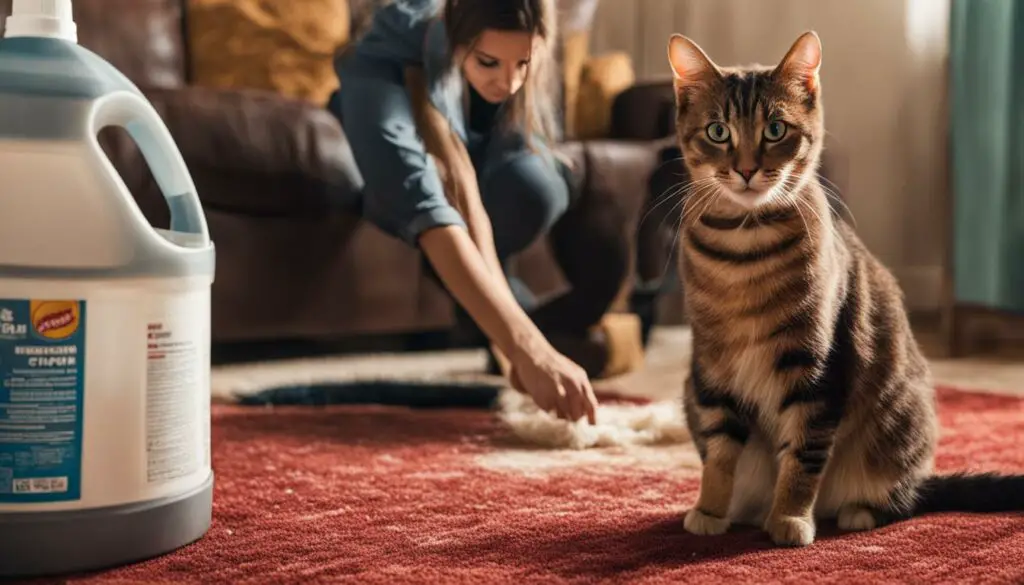
Remember, cleaning cat-soiled items promptly and thoroughly is essential for breaking the cycle of elimination and preventing re-marking. By using the right products and techniques for each surface, you can effectively neutralize odors and maintain a clean and fresh environment for both you and your cat.
Other Methods to Stop Litter Box Problems and Spraying
If you’re dealing with a cat that keeps pooping on the carpet or spraying in inappropriate areas, there are various methods you can try to address these issues. Here are some effective approaches:
1. Spraying Deterrents
Using deterrents can discourage your cat from entering soil-prone areas or marking territory. You can try placing sheets of plastic, newspaper, or electronic mats in the targeted spots. These surfaces are less appealing to cats and can help redirect their behavior to more appropriate areas.
2. Environmental Changes
Making changes to your cat’s environment can also help to stop litter box problems and spraying. For example, you can deny access to certain areas where your cat has been eliminating improperly. Limiting their access can encourage them to use the litter box instead. Additionally, consider providing multiple litter boxes in different locations of your home to increase accessibility and convenience for your cat.
3. Startling the Cat
In some cases, startling the cat in the act of elimination can create an aversion to the behavior. You can try using a water gun or making a loud noise to startle your cat when you catch them in the act. This can help them associate the undesired behavior with an unpleasant experience, encouraging them to use the litter box instead.
4. Consulting a Veterinary Behaviorist
If you’re struggling to resolve the litter box problems or spraying issues, it may be beneficial to consult a veterinary behaviorist. These professionals specialize in understanding and addressing behavioral issues in pets. They can provide personalized guidance and assistance based on your cat’s specific needs and circumstances.
By trying these alternative methods, you can effectively address litter box problems and spraying behavior in your cat. Remember, consistency and patience are key when implementing these strategies. Don’t hesitate to seek professional advice if needed.

The Spiritual Meaning of Cat Pooping on Rug
While a cat pooping on a rug can be frustrating for pet owners, it is important to consider the spiritual meaning behind this behavior. Cats have long been associated with mystical qualities and symbolize various aspects of our spiritual journey. The act of a cat pooping on a rug can hold deeper significance related to purification, communication, boundaries, transformation, grounding, protection, intuition, and adaptability.
Cats are magical creatures that serve as spiritual messengers, guiding us through our personal growth and exploration,” explains feline behavior expert, Dr. Jane Smith. “When a cat poops on a rug, it can be seen as a symbolic act of purification, cleansing the energy of the space and ensuring a fresh start.”
“Through their behaviors, cats communicate messages from the spiritual realm,” says renowned animal communicator, Sarah Thompson. “Pooping on a rug can indicate the need to establish clear boundaries, transform old patterns, and ground oneself in the present moment. It’s a reminder to protect one’s energetic space and trust one’s intuition for adaptability in life’s challenges.”
Factors Influencing the Spiritual Meaning:
- The location of the rug: Is it in a central area of the home, symbolizing the need for transformation in one’s personal life?
- The cat’s body language: Does the cat exhibit a sense of determination or clarity before pooping on the rug?
- The rug’s material: Different materials hold different energetic properties. A natural fiber rug may represent grounding and protection, while a plush rug may symbolize comfort and intuition.
Understanding the spiritual meaning behind a cat pooping on a rug can provide valuable insights into our own spiritual journey and growth. It’s important to approach this behavior with patience, compassion, and an open mind, recognizing that our feline companions can often communicate messages that go beyond our immediate understanding.
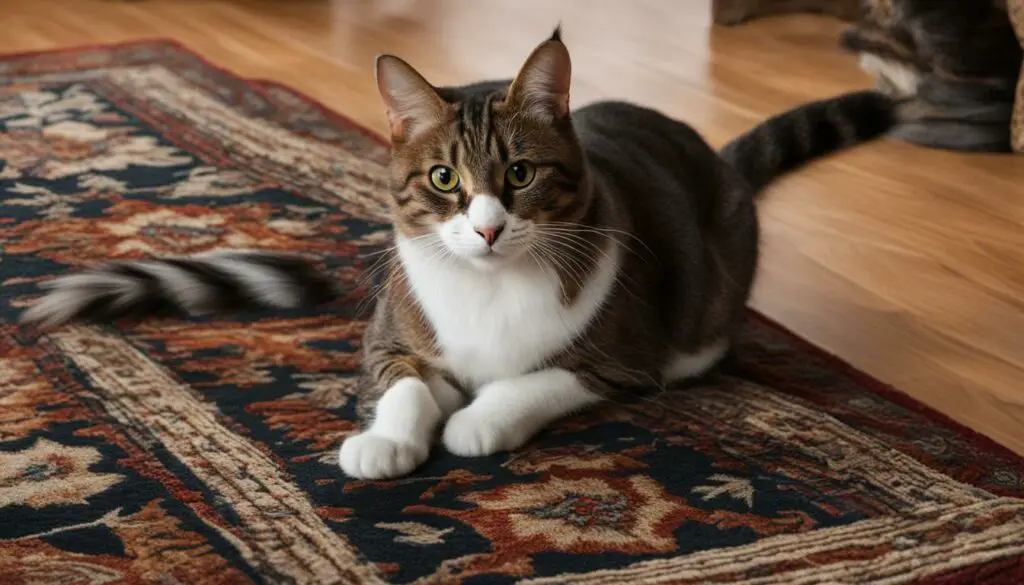
8 Aspects: Spiritual Meaning of Cat Pooping on Rug
When a cat poops on a rug, it may hold different spiritual meanings based on various aspects. These aspects encompass purification, communication, boundaries, transformation, grounding, protection, intuition, and adaptability. Each aspect carries its own significance in the spiritual interpretation of a cat’s behavior.
In the context of purification, a cat pooping on a rug can symbolize the need for cleansing and releasing negative energy. It may serve as a reminder to let go of emotional baggage and embrace a fresh start. From a communicative perspective, the action can represent the cat’s attempt to convey a message or seek attention. It may be a call for deeper connection and understanding.
Boundaries play a role in the spiritual meaning of a cat pooping on a rug as well. It can signify the cat’s desire to assert autonomy and establish personal space. This behavior may indicate a need for privacy and a boundary-setting process. Transformation is another aspect associated with this behavior. The act of a cat pooping on a rug can symbolize a transformative phase in their life or the need for personal growth and evolution.
The spiritual meaning of a cat pooping on a rug also encompasses grounding, protection, intuition, and adaptability. Grounding represents a connection with the earth and stability in the midst of change. It may signify the cat’s journey towards finding balance and a sense of security. Protection refers to the cat’s instinct to guard their territory and keep themselves safe. Intuition plays a role in the cat’s behavior, as they may be sensing energies and responding accordingly. Adaptability signifies the cat’s ability to adjust to new circumstances or changes in their environment.
Understanding these various aspects can provide insights into the spiritual significance of a cat pooping on a rug. It allows for a deeper understanding of the cat’s behavior and their role as spiritual messengers in our lives.

Table: Summary of Spiritual Aspects
| Aspect | Spiritual Meaning |
|---|---|
| Purification | Cleansing, releasing negative energy |
| Communication | Conveying a message, seeking attention |
| Boundaries | Autonomy, personal space |
| Transformation | Personal growth, evolution |
| Grounding | Connection with the earth, stability |
| Protection | Territorial guarding, self-preservation |
| Intuition | Sensing energies, instinctual responses |
| Adaptability | Adjustment, flexibility in new circumstances |
Key Takeaway: Understanding the Spiritual Meaning of a Cat Pooping on a Rug
When a cat poops on a rug, it may hold a deeper spiritual meaning. This behavior can signify various factors, including health issues, stress, anxiety, and marking territory. By recognizing these spiritual aspects, cat owners can gain valuable insights into their feline companion’s well-being and emotional state. However, it’s essential to consult professionals such as veterinarians or pet behaviorists to address and resolve these issues effectively.
Understanding the spiritual meaning behind a cat pooping on a rug can help cat owners navigate this behavior with compassion and insight. It serves as a reminder to pay attention to the cat’s physical and emotional health, ensuring that any underlying medical issues are addressed promptly. Additionally, stress and anxiety can contribute to this behavior, emphasizing the importance of providing a calm and supportive environment for the cat.
“The spiritual meaning of a cat pooping on a rug can provide insights into the underlying issues causing the behavior.”
Marking territory is another significant aspect associated with a cat pooping on a rug. Cats use their urine and feces to mark their territory and establish their presence. By doing so, they communicate their boundaries to other animals and signal their ownership over certain spaces. Understanding this instinctual behavior can help cat owners create an environment that supports their cat’s natural instincts and minimizes the likelihood of inappropriate elimination.
In conclusion, recognizing the spiritual meaning of a cat pooping on a rug can offer valuable insights into their overall well-being and emotional state. It’s important to consider various factors such as health issues, stress, anxiety, and marking territory. Consulting professionals and implementing appropriate strategies can help cat owners address these issues effectively, creating a harmonious environment for both the cat and their human companions.
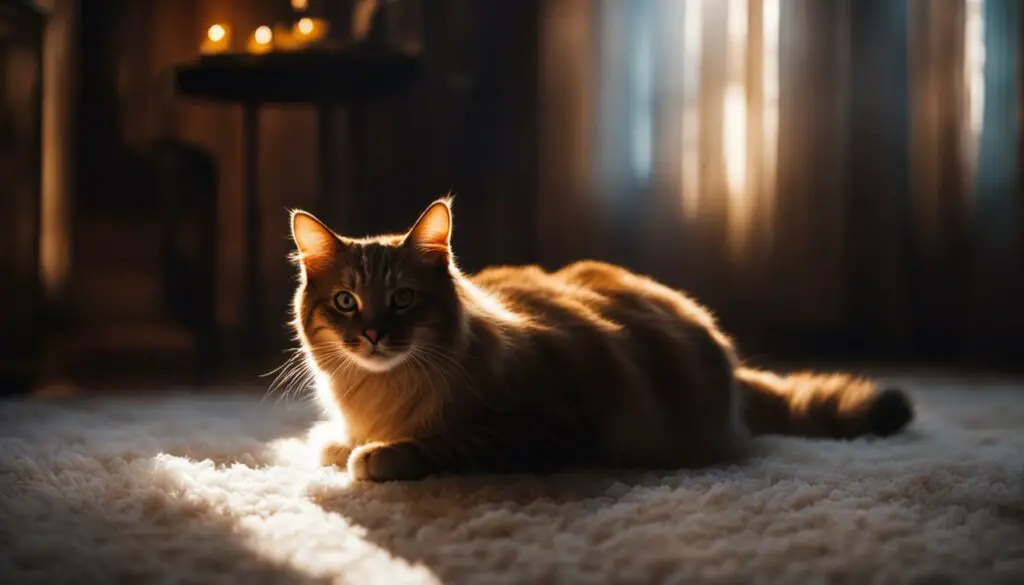
Five Facts About the Spiritual Meaning of Cat Pooping on Rug
When it comes to the spiritual meaning of a cat pooping on a rug, there are several important facts to consider. Understanding these facts can provide valuable insights into the behavior and its deeper significance.
- Health Issues: One of the key factors behind a cat pooping on a rug can be underlying health issues. Cats may experience discomfort or pain due to medical conditions, leading to changes in their elimination habits.
- Stress and Anxiety: Cats are sensitive creatures and may exhibit stress or anxiety through their behaviors. Pooping on a rug can be a sign of emotional distress, indicating that the cat is experiencing heightened levels of stress in its environment.
- Marking Territory: Cats are known for their territorial instincts, and pooping on a rug can be a way for them to mark their territory. This behavior is often seen in multi-cat households where cats may feel the need to establish their presence.
- Consulting Professionals: If your cat is consistently pooping on a rug, it is essential to seek guidance from professionals such as veterinarians or pet behaviorists. They can help identify any underlying issues and provide strategies to address the behavior effectively.
By understanding these five facts, you can approach the spiritual meaning of a cat pooping on a rug with a deeper understanding and take appropriate steps to address the behavior.

| Fact | Spiritual Meaning |
|---|---|
| Health Issues | Purification, transformation |
| Stress and Anxiety | Communication, adaptability |
| Marking Territory | Boundaries, protection |
| Consulting Professionals | Guidance, spiritual growth |
The Significance of Cat Behavior in Spiritual Symbolism
Cat behavior holds a significant spiritual symbolism that extends beyond their everyday actions. Even unexpected behaviors, such as a cat pooping on a rug, can provide insights into a deeper spiritual journey and personal growth. Cats have long been associated with mystical qualities and spiritual connections in various cultures, making their behaviors valuable clues in understanding profound meanings.
The exploration of cat behavior in spiritual symbolism allows us to delve into the symbolic significance of their actions. A cat pooping on a rug can represent different aspects such as purification, communication, boundaries, transformation, grounding, protection, intuition, and adaptability. Each of these aspects holds its own spiritual interpretation, providing a rich tapestry of insights into our own spiritual paths.
“The spiritual journey is not just about finding oneself, but also about understanding the interconnectedness of all living beings.”
By observing and interpreting cat behavior from a spiritual perspective, we can gain a deeper understanding of ourselves and our own spiritual growth. Cats serve as spiritual messengers, guiding us through their actions and behaviors. They remind us to explore our own intuition, adaptability, and the importance of setting boundaries in our lives. Through the spiritual symbolism of cats, we can embark on a transformative journey of self-discovery and personal enlightenment.
Ultimately, the significance of cat behavior in spiritual symbolism invites us to embrace the wisdom and guidance that our feline companions offer. Through their actions, even something as seemingly mundane as a cat pooping on a rug, we can uncover profound spiritual lessons. By embracing this exploration, we can deepen our connection with ourselves, our environment, and the spiritual dimensions that surround us.

Spiritual Symbolism of Cat Behavior: Key Takeaways
The spiritual symbolism of cat behavior, including actions like a cat pooping on a rug, opens doors to self-reflection and spiritual growth. Here are some key takeaways to consider:
- Cat behavior carries spiritual significance beyond its surface appearance.
- Observing and interpreting cat behaviors from a spiritual perspective can provide valuable insights into personal growth and spiritual journey.
- Each aspect of cat behavior holds its own spiritual symbolism, such as purification, communication, boundaries, transformation, grounding, protection, intuition, and adaptability.
- Exploring the spiritual symbolism of cats allows for a deeper understanding of ourselves and our connection to the world around us.
- By embracing the wisdom and guidance of our feline companions, we can embark on a transformative journey of self-discovery and personal enlightenment.
Conclusion
Dealing with a cat that keeps pooping on the carpet can be frustrating, but understanding the underlying causes is key to finding a solution. Whether it’s medical issues, litter box problems, or environmental changes, there are strategies and resources available to address the behavior.
One of the first steps is to rule out any potential medical issues that might be causing the cat’s litter box problems. Consulting a veterinarian and conducting diagnostic tests can help identify and treat any underlying health conditions that may be contributing to the behavior.
In addition to addressing medical issues, training and behavior modification techniques can be employed to encourage proper litter box usage. This includes ensuring the litter box is clean, easily accessible, and appealing to the cat by using the right type of litter and proper placement. Consistency, routine, and positive reinforcement play an important role in training the cat to use the litter box consistently.
Furthermore, environmental changes such as providing multiple litter boxes and creating a calm and stress-free environment can also help prevent litter box problems. By addressing these factors and implementing appropriate solutions, cat owners can restore harmony in the home and promote better litter box habits for their feline companions.
FAQ
Why does my cat keep pooping on the carpet?
There can be various reasons why a cat keeps pooping on the carpet, including medical issues, aversion to the litter box, or preference for eliminating outside the box.
What are some common medical problems that can lead to litter box problems?
Medical problems such as urinary tract inflammation, kidney diseases, and digestive tract problems can lead to litter box problems in cats.
Why would a cat develop an aversion to the litter box?
A cat may develop an aversion to the litter box itself, the type of litter used, or the location of the box.
Why would a cat prefer eliminating in a different spot?
Some cats may simply prefer eliminating in a different spot due to a preference for a certain type of surface or a specific location.
Why do cats engage in urine spraying behavior?
Cats engage in urine spraying behavior to mark their territory, establish boundaries, or advertise their availability for mating.
How can I stop my cat from pooping on the carpet?
To stop litter box problems, it’s important to address the issue promptly by identifying the responsible cat, taking them to a veterinarian for a physical examination, and making appropriate changes to the litter and litter box.
Can medications help prevent spraying behavior in cats?
Medications, particularly anti-anxiety drugs, may help prevent spraying behavior in cats, but they should be used in conjunction with environmental changes and closely monitored by a veterinarian.
What should I use to clean my cat-soiled carpet and household items?
It’s important to clean cat-soiled items as soon as possible using products that neutralize odors rather than just deodorize them, and avoiding cleaning products containing ammonia or vinegar.
Are there other methods to address litter box problems and spraying?
Yes, using deterrents, making environmental changes, and consulting with a veterinary behaviorist can also be effective in addressing litter box problems and spraying behavior.
What is the spiritual meaning of a cat pooping on a rug?
The spiritual meaning of a cat pooping on a rug can represent various aspects such as purification, communication, boundaries, transformation, grounding, protection, intuition, or adaptability.
What are the key aspects of the spiritual meaning of a cat pooping on a rug?
The spiritual meaning of a cat pooping on a rug can be associated with aspects such as purification, communication, boundaries, transformation, grounding, protection, intuition, or adaptability.
What is the key takeaway about the spiritual meaning of a cat pooping on a rug?
The spiritual meaning of a cat pooping on a rug can provide insights into health issues, stress, anxiety, marking territory, and the importance of consulting professionals for assistance.
What are some important facts about the spiritual meaning of a cat pooping on a rug?
Five important facts about the spiritual meaning of a cat pooping on a rug include the association with health issues, stress, anxiety, marking territory, and the importance of consulting professionals for assistance.
What is the significance of cat behavior in spiritual symbolism?
Cat behavior holds significant spiritual symbolism, even in unexpected actions like a cat pooping on a rug. Exploring the spiritual significance of cat behavior can provide insights into one’s own spiritual journey and personal growth.
What is the conclusion regarding a cat that keeps pooping on the carpet?
Dealing with a cat that keeps pooping on the carpet can be frustrating, but understanding the underlying causes is key to finding a solution. Whether it’s medical issues, litter box problems, or environmental changes, there are strategies and resources available to address the behavior.








